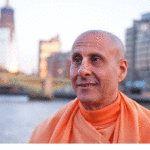The Truth about Loneliness
SPIRITUALITY, 10 May 2021
Radhanath Swami | ISKCON News – TRANSCEND Media Service
1 May 2021 – We all know that diabetes can cause death. And that cigarettes can reduce our life expectancy. But what most of us do not know, is that loneliness can have a similar affect on our health.
On Valentine’s Day last year, the BBC launched the largest ever Loneliness Experiment with 55,000 people from around the world. They found that loneliness is as bad for our health as having a long-term illness such as diabetes or high blood pressure. Loneliness has shown to be as bad for our health as smoking 15 cigarettes a day and to reduce our life expectancy by up to 8 years. The epidemic of loneliness is spreading so fast that it is estimated to affect 1.1 million British people and up to 50% of all Americans.
In the U.S. 1 in 4 people have said that they have no one person to confide in. To make things worse, 75 % of people say that they’re unsatisfied with the friendships that they do have.
Loneliness is not simply that we are alone, rather it is the feeling that you are not connected or loved by the people around you. This is why so many people feel lonely even though their lives are full of people. We may be in relationships, friendships or even be married, yet feel that ache in our hearts.
The root of our disconnection from others is a disconnection from ourselves. When we are not in touch with ourselves, it is very easy to feel alone even in the company of others. We may spend time following others on social media and less time discovering ourselves. We may spend time taking selfies, but less time becoming self-aware. We are prone to superficial relationships with others, simply because we have superficial relationships with ourselves. However, we can overcome loneliness by reconnecting to our true inner self.
The common thing between all of us is the spirit inside. Once we connect with that spirit within us, we are naturally connected to everyone else, in the deepest and most meaningful way. This lets us transform relationships centred around gossip into those focused on giving, from interactions based on lust into ones built on love, and from exchanges based on the externals of our bodies into those based on the internals of our heart.
We may fail to have exchanges of love, because our own hearts are empty. But, when we dig deep and connect to the spirit inside, we are able to access the
foundation of love which lies within, allowing it to flow into every aspect of our lives. Making every exchange we have more fulfilling and feeling fulfillment even when no one else is around.
Mother Teresa has said: “We can cure physical diseases with medicine, but the only cure for loneliness, despair and hopelessness is love. There are many in the world who are dying for a piece of bread, but there are many more dying for a little love.”
_________________________________________
 Radhanath Swami is a Vaishnava sanyassin (a monk in a Krishna-bhakti lineage) and teacher of the devotional path of Bhakti-yoga. He is author of The Journey Home, a memoir of his search for spiritual truth, and the New York Times bestseller The Journey Within. His teachings draw from the sacred texts of India such as the Bhagavad-gita, Srimad Bhagavatam and Ramayana, and aim to reveal the practical application of the sacred traditions, while focusing on the shared essence which unites apparently disparate religious or spiritual paths. Born Richard Slavin, on December 7, 1950, in his teens he came to confront a deep sense of alienation from suburban Chicago life and the civil injustices of mid-century America. At the age of nineteen, while on a summer trip to Europe, his internal struggles culminated in a commitment to search for God wherever it might lead him. Meditating on the Isle of Crete, he felt a supernatural calling and the next morning set off alone to find spiritual India. The Journey Home documents his odyssey as a penniless hitch-hiker though Greece, Turkey, Iran, Afghanistan, Pakistan and finally India. There he lived as a wandering ascetic, first amongst the forest dwelling Himalayan yogis and later amongst a wide variety of gurus and spiritual practitioners throughout India and Nepal. Ultimately, he was led to the holy town of Vrindavan, where he found the teacher he was searching for in A.C. Bhaktivedanta Swami Prabhupada (1896-1977) the founder of the International Society for Krishna Consciousness (ISKCON).
Radhanath Swami is a Vaishnava sanyassin (a monk in a Krishna-bhakti lineage) and teacher of the devotional path of Bhakti-yoga. He is author of The Journey Home, a memoir of his search for spiritual truth, and the New York Times bestseller The Journey Within. His teachings draw from the sacred texts of India such as the Bhagavad-gita, Srimad Bhagavatam and Ramayana, and aim to reveal the practical application of the sacred traditions, while focusing on the shared essence which unites apparently disparate religious or spiritual paths. Born Richard Slavin, on December 7, 1950, in his teens he came to confront a deep sense of alienation from suburban Chicago life and the civil injustices of mid-century America. At the age of nineteen, while on a summer trip to Europe, his internal struggles culminated in a commitment to search for God wherever it might lead him. Meditating on the Isle of Crete, he felt a supernatural calling and the next morning set off alone to find spiritual India. The Journey Home documents his odyssey as a penniless hitch-hiker though Greece, Turkey, Iran, Afghanistan, Pakistan and finally India. There he lived as a wandering ascetic, first amongst the forest dwelling Himalayan yogis and later amongst a wide variety of gurus and spiritual practitioners throughout India and Nepal. Ultimately, he was led to the holy town of Vrindavan, where he found the teacher he was searching for in A.C. Bhaktivedanta Swami Prabhupada (1896-1977) the founder of the International Society for Krishna Consciousness (ISKCON).
Go to Original –iskconnews.org
Tags: Loneliness, Psychology, Radhanath Swami, Spirituality
DISCLAIMER: The statements, views and opinions expressed in pieces republished here are solely those of the authors and do not necessarily represent those of TMS. In accordance with title 17 U.S.C. section 107, this material is distributed without profit to those who have expressed a prior interest in receiving the included information for research and educational purposes. TMS has no affiliation whatsoever with the originator of this article nor is TMS endorsed or sponsored by the originator. “GO TO ORIGINAL” links are provided as a convenience to our readers and allow for verification of authenticity. However, as originating pages are often updated by their originating host sites, the versions posted may not match the versions our readers view when clicking the “GO TO ORIGINAL” links. This site contains copyrighted material the use of which has not always been specifically authorized by the copyright owner. We are making such material available in our efforts to advance understanding of environmental, political, human rights, economic, democracy, scientific, and social justice issues, etc. We believe this constitutes a ‘fair use’ of any such copyrighted material as provided for in section 107 of the US Copyright Law. In accordance with Title 17 U.S.C. Section 107, the material on this site is distributed without profit to those who have expressed a prior interest in receiving the included information for research and educational purposes. For more information go to: http://www.law.cornell.edu/uscode/17/107.shtml. If you wish to use copyrighted material from this site for purposes of your own that go beyond ‘fair use’, you must obtain permission from the copyright owner.
